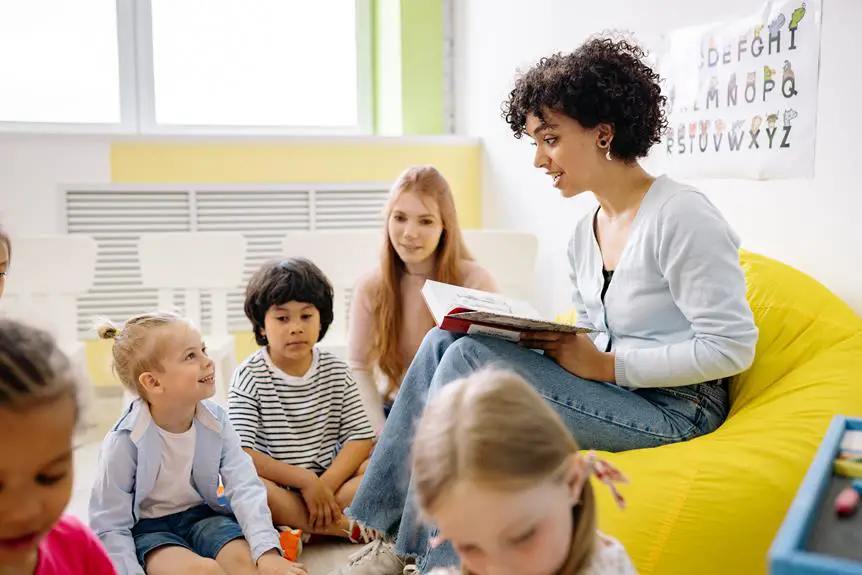Inclusive classrooms have been hailed as the epitome of educational equality, but are they really the holy grail they're made out to be? This article dives into the pros and cons of inclusive classrooms, shedding light on the exaggerated notions surrounding their benefits.
From enhanced social interaction and academic growth to the challenges of individualized support and balancing classroom dynamics, this piece explores the true realities of inclusive education.
Brace yourself for a candid and insightful exploration of this controversial topic.
Key Takeaways
- Enhanced social skills for all students
- Improved academic performance for students with disabilities
- Development of understanding, empathy, and acceptance among all students
- Creation of a sense of community where students learn from each other's strengths and differences
Benefits of Inclusion
The benefits of inclusion in classrooms include enhanced social skills and improved academic performance for all students. When students with disabilities are included in regular classrooms, they have the opportunity to interact with their peers without disabilities, which helps develop their social skills. This interaction promotes understanding, empathy, and acceptance among all students. Inclusive classrooms also create a sense of community where students learn from each other's strengths and differences.
Moreover, inclusion has been shown to positively impact academic performance. Students with disabilities who are included in general education classrooms receive the necessary support and accommodations to succeed academically. They have access to the same curriculum as their peers and benefit from the differentiated instruction provided by teachers. Inclusive classrooms foster a supportive learning environment where students feel valued and motivated to achieve their potential.
Research has consistently demonstrated that inclusive education benefits not only students with disabilities but also their typically developing peers. Typically developing students gain a deeper understanding of diversity, empathy, and acceptance. They learn to appreciate and respect individual differences, which prepares them for the diverse world they will face beyond the classroom.
Enhanced Social Interaction
Enhanced social interaction in inclusive classrooms can lead to improved peer relationships and increased empathy development among students.
By interacting with peers from diverse backgrounds and abilities, students have the opportunity to build meaningful connections and learn from each other's experiences.
This inclusive environment fosters a sense of understanding, acceptance, and collaboration, which can have a positive impact on the overall social development of all students involved.
Improved Peer Relationships
In inclusive classrooms, students experience improved peer relationships through enhanced social interaction. This positive aspect of inclusive education has several benefits:
- Increased empathy: Interacting with students from diverse backgrounds helps develop empathy and understanding among classmates. Students learn to appreciate and respect different perspectives, fostering a sense of inclusivity.
- Enhanced social skills: In inclusive classrooms, students have more opportunities to engage with peers of various abilities and backgrounds. This promotes the development of crucial social skills, such as communication, cooperation, and problem-solving.
- Reduced stereotypes and prejudice: By regularly interacting with students with disabilities or different cultural backgrounds, stereotypes and prejudices are challenged and dispelled. This leads to a more inclusive and accepting school environment.
- Friendships and support networks: Inclusive classrooms provide a platform for students to form meaningful friendships and support networks. Students with disabilities benefit from the social connections and support of their peers, while their classmates learn valuable lessons about empathy, acceptance, and diversity.
Increased Empathy Development
Students in inclusive classrooms experience increased empathy development and enhanced social interaction, which has numerous positive effects on their overall growth and understanding of others. By interacting with students from diverse backgrounds, abilities, and experiences, students in inclusive classrooms learn to appreciate and accept differences in others. This fosters a sense of empathy and compassion as they gain a deeper understanding of the challenges and perspectives of their peers. Moreover, the enhanced social interaction in inclusive classrooms allows students to develop crucial social skills such as communication, cooperation, and conflict resolution. This prepares them for real-world situations where they will encounter individuals with different abilities and backgrounds. The following table highlights some of the benefits of increased empathy development and enhanced social interaction in inclusive classrooms:
| Benefits of Increased Empathy Development and Enhanced Social Interaction | ||
|---|---|---|
| Improved understanding of diversity | Strengthened communication skills | Increased tolerance and acceptance |
| Enhanced problem-solving skills | Development of teamwork and cooperation | Cultivation of empathy and compassion |
| Promotion of a positive classroom climate | Fostering of friendships and social connections | Preparation for real-world interactions |
Academic Growth for All
The inclusive classroom fosters academic growth for all students. By creating an environment that embraces diversity and promotes equal opportunities, inclusive classrooms have several benefits that contribute to the academic growth of every student:
- Collaborative learning: Inclusive classrooms encourage collaboration among students with diverse abilities and backgrounds. This collaborative approach allows students to learn from each other's strengths and challenges, fostering a deeper understanding of the subject matter.
- Individualized instruction: Inclusive classrooms often employ differentiated instruction strategies to meet the unique needs of each student. Teachers can tailor their teaching methods and materials to accommodate different learning styles, ensuring that all students can actively engage and succeed academically.
- Improved problem-solving skills: In an inclusive classroom, students are exposed to a wide range of perspectives and problem-solving strategies. This exposure enhances their critical thinking skills and helps them develop creative solutions to complex problems.
- Increased self-confidence: Inclusive classrooms provide opportunities for students to showcase their abilities and contributions. By recognizing and valuing each student's individual strengths, inclusive classrooms promote a sense of belonging and self-confidence, leading to improved academic performance.
Individualized Support Challenges
Challenges in providing individualized support arise in inclusive classrooms. Inclusive classrooms aim to provide support for students with diverse needs, but the reality of meeting individualized needs can be complex.
One of the main challenges is the wide range of learning abilities and needs present in the classroom. Teachers must find effective strategies to address the needs of students who may require different levels of support. This can be time-consuming and challenging, as teachers must balance the needs of all students while ensuring that individualized support is provided.
Another challenge is the limited resources available to meet individualized needs. Inclusive classrooms often have limited funding, which can make it difficult to provide the necessary resources and accommodations for all students. This can result in a lack of specialized support, such as assistive technology or additional personnel, that could greatly benefit students with specific needs.
Additionally, the lack of training and professional development for teachers can pose challenges in providing individualized support. Teachers may not have the necessary skills or knowledge to effectively support students with diverse needs. Inclusive classrooms require teachers to have a deep understanding of different learning styles, instructional strategies, and accommodations. Without proper training, teachers may struggle to provide the individualized support that students require.
Balancing Classroom Dynamics
Finding a balance in classroom dynamics can sometimes be a challenging task for teachers in inclusive classrooms, as they must frequently navigate the diverse needs and abilities of their students. In order to create an inclusive and supportive learning environment, teachers must consider the following:
- Individualized instruction: Teachers should provide instruction that's tailored to meet the unique needs of each student. This may involve differentiating assignments, adapting teaching strategies, and offering additional support.
- Collaboration: Encouraging collaboration among students fosters a sense of community and promotes positive relationships. Teachers can facilitate group work, peer tutoring, and cooperative learning activities to promote teamwork and inclusivity.
- Clear expectations and routines: Establishing clear expectations and routines helps create a structured and predictable learning environment. This benefits all students, but is particularly important for students with special needs who may thrive in a structured environment.
- Regular communication: Open and regular communication with students, parents, and support staff is crucial for maintaining a balanced classroom dynamic. This allows for the sharing of information, addressing concerns, and seeking feedback to ensure all students' needs are met.
Teacher Training and Support
Teachers in inclusive classrooms often receive training and support to effectively meet the diverse needs of their students. This training equips them with the necessary skills and strategies to create an inclusive and supportive learning environment. It helps teachers understand the individual strengths and challenges of each student, enabling them to tailor their instruction and accommodations accordingly.
One of the key benefits of teacher training in inclusive classrooms is the development of differentiated instruction techniques. Teachers learn how to modify their teaching methods to cater to students' varying learning styles and abilities. They gain insights into effective instructional strategies, such as multisensory approaches, cooperative learning, and scaffolding, which can benefit all students, regardless of their abilities.
Moreover, teacher training focuses on fostering a positive classroom culture that promotes acceptance, empathy, and respect. Teachers learn techniques to cultivate an inclusive community where all students feel valued and supported. They're trained in conflict resolution strategies and taught how to address any potential issues that may arise in an inclusive classroom setting.
However, it's essential to note that teacher training and support are ongoing processes. Inclusive classrooms pose unique challenges, and teachers need continuous professional development and access to resources to stay updated with best practices. Collaboration with special education professionals and ongoing support from administrators and colleagues are crucial for teachers to effectively implement inclusive practices and address the diverse needs of their students.
Parent and Community Involvement
Parent and community involvement in inclusive classrooms can have numerous benefits. When parents and community members are actively engaged in their child's education, it creates a strong support system and fosters a sense of belonging for the student.
However, there can also be potential challenges, such as conflicting expectations or lack of resources, that may need to be addressed in order to ensure successful collaboration.
Benefits of Involvement
A significant number of studies have shown that active involvement from parents and the community in inclusive classrooms yields numerous benefits for students. Here are four key benefits of such involvement:
- Academic success:
When parents and the community actively participate in their children's education, students tend to perform better academically. They receive additional support, resources, and guidance, which contribute to improved learning outcomes.
- Increased motivation:
When students see their parents and community members engaging in their education, it instills a sense of value and importance. This involvement boosts their motivation, leading to increased effort, participation, and overall engagement in the classroom.
- Social and emotional development:
Parent and community involvement provides students with a strong support system. This support helps them develop positive relationships, build self-esteem, and enhance their social and emotional well-being.
- Enhanced communication and collaboration:
Inclusive classrooms thrive on open communication and collaboration. When parents and the community actively participate, they become valuable partners in the educational process. They can share insights, provide feedback, and collaborate with teachers to create a more effective learning environment.
Potential Challenges Faced
One potential challenge faced in inclusive classrooms is that some individuals may feel hesitant to actively engage in parent and community involvement. This can be due to various factors such as lack of time, limited resources, or a lack of understanding and awareness about the benefits of involvement.
Some parents may feel overwhelmed with their own personal responsibilities and may struggle to find the time and energy to participate in their child's education. Additionally, there may be cultural or language barriers that prevent effective communication between school and home. Lack of community involvement can also be a challenge, as it may result in a lack of resources and support for the inclusive classroom.
Overcoming these challenges requires a collaborative effort between educators, parents, and the community to create a welcoming and inclusive environment that encourages active involvement.
Frequently Asked Questions
How Can Inclusive Classrooms Benefit Students With Disabilities?
Inclusive classrooms benefit students with disabilities by promoting social integration, fostering a sense of belonging, and providing opportunities for individualized support. They create an environment where all students can learn and grow together.
What Strategies Can Be Implemented to Enhance Social Interaction in Inclusive Classrooms?
To enhance social interaction in inclusive classrooms, teachers can implement strategies such as peer buddy systems, cooperative learning activities, and group projects. These strategies foster collaboration and cooperation among all students, promoting a sense of belonging and friendship.
What Are the Potential Challenges of Providing Individualized Support in Inclusive Classrooms?
Potential challenges of providing individualized support in inclusive classrooms include limited resources, time constraints, and the need for specialized training. However, with proper planning and collaboration, teachers can overcome these challenges and ensure that all students receive the support they need to succeed.
How Can Teachers Effectively Balance the Dynamics of an Inclusive Classroom?
Teachers can effectively balance the dynamics of an inclusive classroom by fostering a supportive and inclusive environment. They should differentiate instruction, promote collaboration, and provide individualized support to meet the diverse needs of students.
What Types of Training and Support Are Available for Teachers in Inclusive Classrooms?
Teachers in inclusive classrooms can access various types of training and support. These resources help them develop strategies for meeting the diverse needs of their students, fostering an inclusive environment, and effectively managing classroom dynamics.








